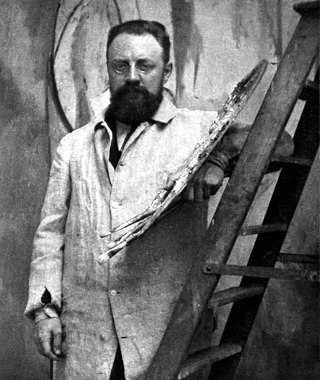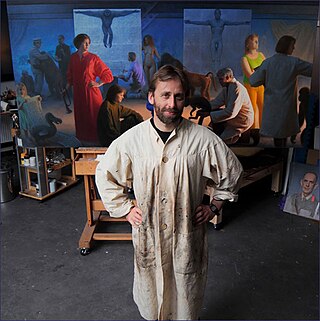
Henri Émile Benoît Matisse was a French visual artist, known for both his use of colour and his fluid and original draughtsmanship. He was a draughtsman, printmaker, and sculptor, but is known primarily as a painter. Matisse is commonly regarded, along with Pablo Picasso, as one of the artists who best helped to define the revolutionary developments in the visual arts throughout the opening decades of the twentieth century, responsible for significant developments in painting and sculpture.

André Derain was a French artist, painter, sculptor and co-founder of Fauvism with Henri Matisse.

Henri Fantin-Latour was a French painter and lithographer best known for his flower paintings and group portraits of Parisian artists and writers.

Diego Rodríguez de Silva y Velázquez was a Spanish painter, the leading artist in the court of King Philip IV of Spain and Portugal, and of the Spanish Golden Age. He was an individualistic artist of the Baroque period. He began to paint in a precise tenebrist style, later developing a freer manner characterized by bold brushwork. In addition to numerous renditions of scenes of historical and cultural significance, he painted scores of portraits of the Spanish royal family and commoners, culminating in his masterpiece Las Meninas (1656).
Abstract expressionism is a post–World War II art movement in American painting, developed in New York City in the 1940s. It was the first specifically American movement to achieve international influence and put New York at the center of the Western art world, a role formerly filled by Paris.

Bartolomé Esteban Murillo was a Spanish Baroque painter. Although he is best known for his religious works, Murillo also produced a considerable number of paintings of contemporary women and children. These lively realistic portraits of flower girls, street urchins, and beggars constitute an extensive and appealing record of the everyday life of his times. He also painted two self-portraits, one in the Frick Collection portraying him in his 30s, and one in London's National Gallery portraying him about 20 years later. In 2017–18, the two museums held an exhibition of them.

Francisco de Zurbarán was a Spanish painter. He is known primarily for his religious paintings depicting monks, nuns, and martyrs, and for his still-lifes. Zurbarán gained the nickname "Spanish Caravaggio", owing to the forceful use of chiaroscuro in which he excelled.

Jusepe de Ribera was a painter and printmaker, who along with Francisco de Zurbarán, Bartolomé Esteban Murillo, and the singular Diego Velázquez, are regarded as the major artists of Spanish Baroque painting. Referring to a series of Ribera exhibitions held in the late 20th century, Philippe de Montebello wrote "If Ribera's status as the undisputed protagonist of Neapolitan painting had ever been in doubt, it was not longer. Indeed, to many it seemed that Ribera emerged from these exhibitions as not simply the greatest Neapolitan artist of his age but one of the outstanding European masters of the seventeenth century." Jusepe de Ribera has also been referred to as José de Ribera, Josep de Ribera, and Lo Spagnoletto by his contemporaries, early historians, and biographers.

Théophile Alexandre Steinlen, was a Swiss-born French Art Nouveau painter and printmaker. He was politically engaged and collaborated with anarchist and socialist press.

Antonio López García is a Spanish painter and sculptor, known for his realistic style. He is criticized by some modern artists for what they consider neo-academism, but has been praised by leading art critics, such as Robert Hughes, who considered him "the greatest realist artist alive" in 1986. His style sometimes is deemed hyperrealistic. His painting was the subject of the film El Sol del Membrillo, by Victor Erice, in 1992.
Juan Sánchez Cotán was a Spanish Baroque painter, a pioneer of realism in Spain. His still lifes and bodegones were painted in an austere style, especially when compared to similar works in the Netherlands and Italy.
Francisco Díaz de León was a Mexican graphic artist, notable for pioneering much of modern Mexican graphic arts. He spent his childhood around books and when he studied art in Mexico City, he specialized in engraving and illustration. He spent his career illustrating books, magazines and more, reviving techniques such as dry point and introducing new techniques and styles such as the use of color and linoleum printing. He was also a noted arts education, directing several schools including the Escuela Mexicana de las Artes del Libro, which he founded. He was a founding member of the Academia de Artes and a member of the Salón de la Plástica Mexicana. In 1969 he received the Premio Nacional de Artes for engraving.
Antonio M. Ruíz, was a Mexican fine art painter and scenic designer otherwise known by his childhood nickname "El Corzo" or "El Corcito" (diminutive) which came about due to his resemblance to a popular Spanish bullfighter or torero.

Jorge Octavio Morel Tavárez was a Dominican painter, musician, and teacher born in Santiago de los Caballeros, Dominican Republic; he is remembered as the leading costumbrista painter in the country and one of the early progenitors of the Dominican modernist school of painting, along with contemporaries Jaime Colsón, Darío Suro, and Celeste Woss y Gil.

Fauvism /ˈfoʊvɪzm̩/ is the style of les Fauves, a group of early 20th-century modern artists whose works emphasized painterly qualities and strong colour over the representational or realistic values retained by Impressionism. While Fauvism as a style began around 1904 and continued beyond 1910, the movement as such lasted only a few years, 1905–1908, and had three exhibitions. The leaders of the movement were André Derain, Maurice de Vlaminck, and Henri Matisse.

Clara Ledesma Terrazas was an artist from the Dominican Republic.
Mariano Paredes Limón was a Mexican artist, best known for his engraving work.

The Rape of the Sabine Women is a painting by Peter Paul Rubens. It is now in the Belfius Collection. It was commissioned by Philip IV of Spain in 1639 but was still incomplete on Rubens' death a year later. It was completed by the Brussels painter Gaspar de Crayer.

Conor Walton is an Irish figurative painter. Walton lives and works in Wicklow, Ireland.

William Bryan Jordan Jr. was an American art historian who facilitated acquisitions, curated exhibitions, and authored publications on Spanish artists and still life paintings, particularly from the Golden Age.















